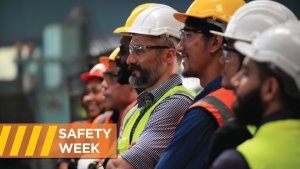Although we can’t predict the future, no one will be surprised if, a few years from now, COVID-19 has changed many of the tried-and-true ways the construction industry has designed and erected buildings.
To get an idea of what the future might have in store for us, the Journal of Commerce asked a number of construction professionals in British Columbia (and one in the U.S.) what they think might be coming down the pike and what questions they’re asking themselves about our brave new construction world.
“The possible impact of COVID-19 on the built environment poses many questions, but few answers,” said architect Michael Leckie, principal of Leckie Studio Architecture and Design Inc. “For example, what are the short-term and long-term effects? Will they be temporary or long-lasting? What aspects of our lives will be affected?”
Leckie says the pandemic strains the connection between place (e.g. office, university campus) and activity (e.g. work, education).
“In education, what is required in the way of a physical building, and how much proximity between teachers and students is optimal or even required?” said Leckie. “Campus buildings are expensive to design and build. Technology provides the tools for distance learning and it can mediate and enhance the learning process.”
I don’t think there will be major structural change, but it could lead to design innovations,
— Mark Taylor
Mark Taylor Construction Advisory Services
Along the same lines as Leckie, Lynn Embury-Williams, executive director of Wood WORKS! BC, says project developers will need to offer more flexible space in the future.”
“There will be increased demand for spare rooms at home and school, and for more home amenity spaces.” said Williams. “They will also need to pay greater attention to people-flow planning, for such things as elevators and hallways. And because there could be demand for grocery pick-up and delivery, designers will need to include out-bays on commercial buildings.”
Because we’ve learned that we can work efficiently and productively away from the office, in the future there could be greater demand for more working space at home, says Mark Taylor, president of Mark Taylor Construction Advisory Services Ltd.
“I don’t think there will be major structural change, but it could lead to design innovations to include more workspace in residences,” he said.
Taylor says after COVID-19 has finished its run and returned home, construction sites won’t go back to how they used to operate.
“We’ll all be wearing gloves and other PPE [Personal Protection Equipment], at least in the immediate post-pandemic period,” he said. “It depends on how long our collective memory of the pandemic lasts.”
Taylor says it’s unclear what effect the pandemic will have on the construction industry’s labour supply problems.
“Before COVID-19 struck it was already hard to find qualified labour,” said Taylor. “Afterwards there could be an influx of inexperienced labour from outside construction to fill vacant positions. What effect will that have on the overall skill level?”
Metric Modular director of innovative solutions Craig Mitchell says in the future there will be a demand for special pandemic facilities that will be different from regular hospitals.
“The pandemic facilities will be more basic than the very complex and technical hospitals,” he said. “The big contractors that do the highly sophisticated hospital projects will probably get into the less complex pandemic facilities, too.”
Lucas Epp, head of engineering at StructureCraft, says developers have become more cautious, because there are questions about the future of the workplace, and the extent to which white-collar workers will work from home instead of commuting to the office.
“But developers will always want to differentiate their projects from others so they can find tenants,” said Epp.
Regarding the design and construction of institutional-commercial-industrial (ICI) and multi-family residential buildings in the post-COVID -19 future, Tom Hardiman, executive director of the Modular Building Institute in Washington, D.C., says it is unclear what affect the pandemic will have.
“What we do know is that, before the COVID crisis, many North American communities faced homelessness and affordable housing challenges,” said Hardiman. “Vancouver is ahead of the curve, having already explored and implemented modular solutions to address some of these issues.”
Hardiman says the COVID-19 crisis also brought to light the need to do better on worker and workplace safety.
“It’s challenging to enforce social distancing and sanitary workspaces on a traditional job site, but more manageable at off-site factory locations,” said Hardiman. “And I think the new normal will be construction workers expecting safer working conditions, and rightfully so.”











Recent Comments
comments for this post are closed